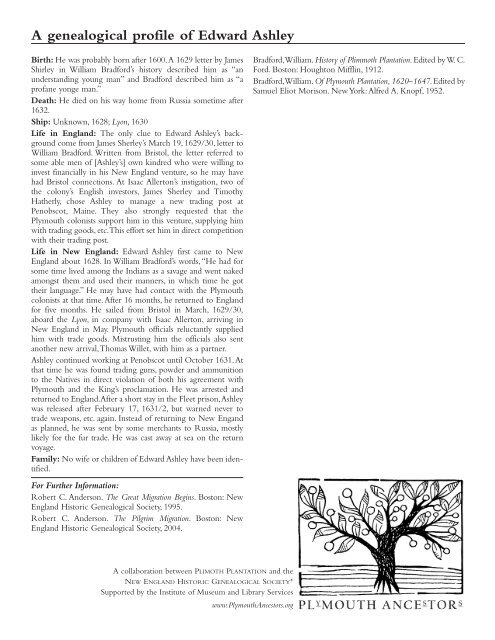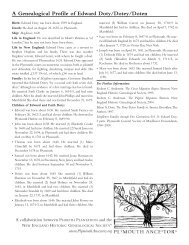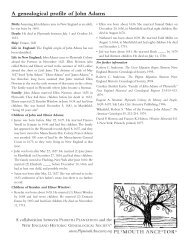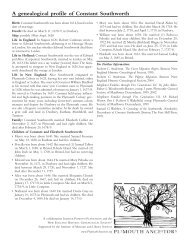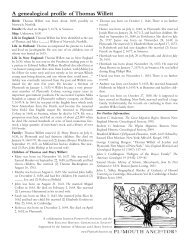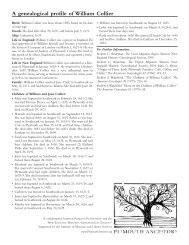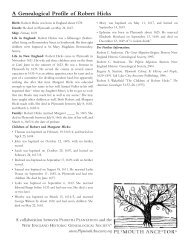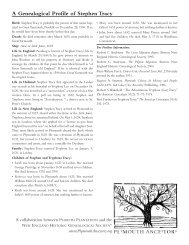Edward Ashley - Plimoth Plantation
Edward Ashley - Plimoth Plantation
Edward Ashley - Plimoth Plantation
Create successful ePaper yourself
Turn your PDF publications into a flip-book with our unique Google optimized e-Paper software.
A genealogical profile of <strong>Edward</strong> <strong>Ashley</strong><br />
Birth: He was probably born after 1600.A 1629 letter by James<br />
Shirley in William Bradford’s history described him as “an<br />
understanding young man” and Bradford described him as “a<br />
profane yonge man.”<br />
Death: He died on his way home from Russia sometime after<br />
1632.<br />
Ship: Unknown, 1628; Lyon, 1630<br />
Life in England: The only clue to <strong>Edward</strong> <strong>Ashley</strong>’s background<br />
come from James Sherley’s March 19, 1629/30, letter to<br />
William Bradford. Written from Bristol, the letter referred to<br />
some able men of [<strong>Ashley</strong>’s] own kindred who were willing to<br />
invest financially in his New England venture, so he may have<br />
had Bristol connections. At Isaac Allerton’s instigation, two of<br />
the colony’s English investors, James Sherley and Timothy<br />
Hatherly, chose <strong>Ashley</strong> to manage a new trading post at<br />
Penobscot, Maine. They also strongly requested that the<br />
Plymouth colonists support him in this venture, supplying him<br />
with trading goods, etc.This effort set him in direct competition<br />
with their trading post.<br />
Life in New England: <strong>Edward</strong> <strong>Ashley</strong> first came to New<br />
England about 1628. In William Bradford’s words, “He had for<br />
some time lived among the Indians as a savage and went naked<br />
amongst them and used their manners, in which time he got<br />
their language.” He may have had contact with the Plymouth<br />
colonists at that time. After 16 months, he returned to England<br />
for five months. He sailed from Bristol in March, 1629/30,<br />
aboard the Lyon, in company with Isaac Allerton, arriving in<br />
New England in May. Plymouth officials reluctantly supplied<br />
him with trade goods. Mistrusting him the officials also sent<br />
another new arrival,Thomas Willet, with him as a partner.<br />
<strong>Ashley</strong> continued working at Penobscot until October 1631.At<br />
that time he was found trading guns, powder and ammunition<br />
to the Natives in direct violation of both his agreement with<br />
Plymouth and the King’s proclamation. He was arrested and<br />
returned to England.After a short stay in the Fleet prison,<strong>Ashley</strong><br />
was released after February 17, 1631/2, but warned never to<br />
trade weapons, etc. again. Instead of returning to New Engand<br />
as planned, he was sent by some merchants to Russia, mostly<br />
likely for the fur trade. He was cast away at sea on the return<br />
voyage.<br />
Family: No wife or children of <strong>Edward</strong> <strong>Ashley</strong> have been identified.<br />
For Further Information:<br />
Robert C. Anderson. The Great Migration Begins. Boston: New<br />
England Historic Genealogical Society, 1995.<br />
Robert C. Anderson. The Pilgrim Migration. Boston: New<br />
England Historic Genealogical Society, 2004.<br />
A collaboration between PLIMOTH PLANTATION and the<br />
NEW ENGLAND HISTORIC GENEALOGICAL SOCIETY ®<br />
Supported by the Institute of Museum and Library Services<br />
www.PlymouthAncestors.org<br />
Bradford,William. History of Plimmoth <strong>Plantation</strong>. Edited by W. C.<br />
Ford. Boston: Houghton Mifflin, 1912.<br />
Bradford,William. Of Plymouth <strong>Plantation</strong>, 1620–1647. Edited by<br />
Samuel Eliot Morison. New York:Alfred A. Knopf, 1952.
Researching your family’s history can be a fun, rewarding, and occasionally<br />
frustrating project. Start with what you know by collecting information<br />
on your immediate family. Then, trace back through parents,<br />
grandparents, and beyond.This is a great opportunity to speak to relatives,<br />
gather family stories, arrange and identify old family photographs, and<br />
document family possessions that have been passed down from earlier<br />
generations.<br />
Once you have learned all you can from family members, you will<br />
begin to discover other sources. A wide variety of records can help you learn more about the lives of your ancestors.These<br />
include birth, marriage, and death records; immigration and naturalization records; land records; census records; probate records<br />
and wills; church and cemetery records; newspapers; passenger lists; military records; and much more.<br />
When you use information from any source — an original record, a printed book, or a website — always be careful to document<br />
it. If you use a book, you should cite the author or compiler, the full title, publication information and pages used.Also<br />
be sure to record the author’s sources for the information. If the author’s sources aren’t provided, you will have to try to find<br />
the original source. Many genealogical works contain faulty information, and the Internet also contains many inaccuracies. In<br />
order for your work to be accepted — by lineage societies and other genealogists — it must be properly documented.<br />
IMPORTANT GENEALOGICAL RESOURCES<br />
New England Historic Genealogical Society<br />
Founded in 1845, NEHGS is the country’s oldest and largest<br />
genealogical society.The library contains over 200,000 books,<br />
plus significant manuscript and microfilm collections, and a circulating<br />
library by mail. NEHGS members receive two periodicals,<br />
the Register and New England Ancestors, and can access<br />
valuable genealogical data online.<br />
NEHGS, 101 Newbury St., Boston, MA 02116;<br />
888-296-3447; www.NewEnglandAncestors.org.<br />
<strong>Plimoth</strong> <strong>Plantation</strong>: Bringing Your History To Life<br />
As a non-profit, educational organization our mission is: to offer<br />
the public powerful experiences of history, built upon thorough<br />
research of the Wampanoag and Pilgrim communities.We offer<br />
multiple learning opportunities to provide a deeper understanding<br />
of the relationship of historical events to modern America.<br />
Members have access to our Research Library.<br />
<strong>Plimoth</strong> <strong>Plantation</strong>, 137 Warren Avenue, Plymouth, MA 02632;<br />
508-746-1622; www.plimoth.org<br />
RECOMMENDED WEBSITES<br />
www.PlymouthAncestors.org<br />
www.CyndisList.com<br />
www.FamilySearch.org<br />
www.USGenWeb.org<br />
GENEALOGICAL LIBRARIES IN PLYMOUTH<br />
General Society of Mayflower Descendants Library<br />
A collection focused principally on the genealogies of the<br />
descendants of the Mayflower passengers.<br />
4 Winslow St., Plymouth; 508-746-3188; www.mayflower.org<br />
Plymouth Collection, Plymouth Public Library<br />
Over 1200 items relating to the descendants of the Pilgrims, as<br />
well as the many other immigrants who settled in the area.<br />
132 South St., Plymouth; 508-830-4250;<br />
www.plymouthpubliclibrary.org<br />
RECOMMENDED BOOKS<br />
The Complete Idiot’s Guide to Genealogy by Christine Rose and<br />
Kay Germain Ingalls,Alpha Books, 1997.<br />
Genealogist’s Handbook for New England Research by Marcia<br />
Melnyk, NEHGS, 1999.<br />
Shaking Your Family Tree:A Basic Guide to Tracing Your Family<br />
History by Ralph J. Crandall, NEHGS, 2001.<br />
Unpuzzling Your Past by Emily Croom, Betterway Books, 2003.<br />
A collaboration between PLIMOTH PLANTATION and the<br />
NEW ENGLAND HISTORIC GENEALOGICAL SOCIETY ®<br />
www.PlymouthAncestors.org


